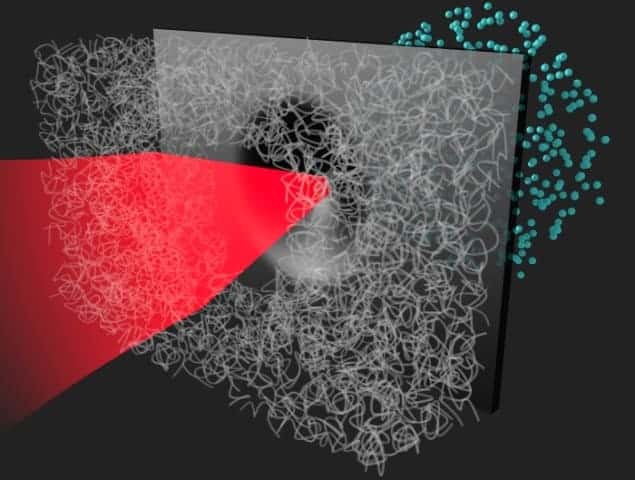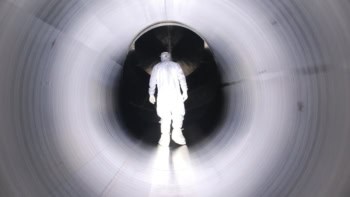
An international research team has used carbon nanotubes to enhance the efficiency of laser acceleration, bringing table-top sources for carbon-ion therapy a step closer to reality. Therapeutic ion beams are currently delivered using large, expensive particle accelerators. Laser-driven ion acceleration may one day provide a compact, cost-effective alternative – but current techniques cannot match the energy and quality of beams created by conventional accelerators.
Laser-driven ion acceleration typically works by firing high-intensity laser pulses at ultrathin diamond-like carbon foils. The light pulses strip electrons from atoms in the foil, generating a negatively charged electron plasma. This plasma creates an electric field that then accelerates positively charged carbon ions stripped from the foil.
Now, a team led by Jörg Schreiber at LMU Munich has calculated that the energy of the resulting carbon ions could be boosted by using laser pulses with a steep (few-femtosecond) rising edge. Such pulses would allow an efficient process called radiation pressure acceleration (RPA). Generating such pulses experimentally, however, is a formidable challenge. “RPA is the most efficient way to accelerate ions,” says Schreiber. “In particular, RPA promotes substantially more ions to high energies as compared to other schemes, and eventually even allows for non-exponential energy distributions.”
Pulse shaping
To create optimally shaped laser pulses, Schreiber and colleagues coated one side of a 10 nm-thick diamond-like carbon foil with a foam of carbon nanotubes. When the laser irradiates the nanotube foam, a near-critical-density plasma is formed, which acts like a lens and focuses the traversing laser pulses. “The CNT foam provides a plasma that acts as a nonlinear medium to shape the laser, both temporally and spatially, to become better suited for RPA,” explains Schreiber.
To test their approach, the researchers carried out experiments using femtosecond pulses from the Gemini laser at the Rutherford Appleton Laboratory. Comparing the temporal shapes of an incident laser pulse and a pulse transmitted through the carbon nanotube layer revealed significant pulse steepening, with the pulse rise time reduced to about 4 fs by the nanotubes. The laser intensity is also increased and reaches peak values of more than 10 times the peak vacuum-focused intensity. This extremely steep-rising edge accompanied with much higher peak intensity provides ideal conditions for RPA to occur.
The researchers recorded the ion spectra generated upon firing circularly polarized laser pulses onto diamond-like carbon films with different carbon-nanotube foam thicknesses. They found that ion energies increased with increasing carbon-nanotube foam thickness. The best performance was observed for the thickest layer (5 µm), which increased the maximum energy of accelerated carbon ions by approximately a factor of three over an uncoated diamond-like carbon foil – from 80 to almost 240 MeV.
Boosted output
This maximum energy (20 MeV per nucleon) is significantly higher than previously attained by laser-driven ion acceleration, and makes experiments on cells with beams of carbon ions feasible for the first time. However, energies of at least 1 GeV will be required for clinical applications – about five times higher than that attained in this work.
According to the researchers, boosting power output to this level is not impossible. Future experiments will exploit the 3 PW ATLAS-3000 ultrashort pulsed laser, which will be located at a new Centre for Advanced Laser Applications (CALA) being built in Garching. Combined with the energy enhancement from the nanotube-coated foils, this system could help make laser ion acceleration a more viable tool.
The team also plans to advance from proof-of-principle experiments demonstrating the creation of 20 MeV/atomic-mass-unit carbon ions in a few shots, towards experiments with ion bunches. This will include cell experiments and, in the near future, also small-animal studies.
“In parallel, we are scattering the globe to advertise the state-of-the-art of laser acceleration, to raise awareness among potential applicants in various fields of science,” adds Schreiber. As for whether laser-driven ion acceleration will ultimately enable a low-cost particle-therapy system, Schreiber says that this is a tough call to make. “The challenge is not simply to make a cheaper accelerator – laser acceleration should provide some new quality that is not or hardly accessible by other means,” he says. “This feature is certainly the bunched nature and the synchronicity to other laser-driven sources of radiation. Even the multi-ion species available in one shot could turn out to be a benefit. The next years will be exciting as we approach medically relevant energies and exploit the first applications that utilize these special features.”
The research is published in Physical Review Letters.
- This article was first published on medicalphysicsweb.org



